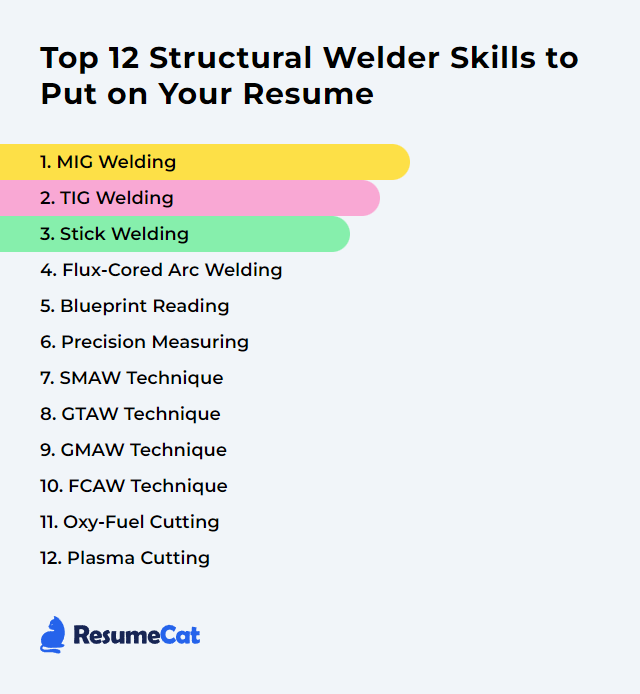Top 12 Structural Welder Skills to Put on Your Resume
Crafting an effective resume as a structural welder means showing the full picture: sharp technical chops, reliable safety habits, and the calm, steady focus that holds big steel together. Put your core processes front and center, call out certifications and code familiarity (think AWS D1.1, D1.5 where relevant), and weave in teamwork, problem-solving, and quality control. The right mix signals you’re battle-tested on real jobs, not just in a booth.
Structural Welder Skills
- MIG Welding
- TIG Welding
- Stick Welding
- Flux-Cored Arc Welding
- Blueprint Reading
- Precision Measuring
- SMAW Technique
- GTAW Technique
- GMAW Technique
- FCAW Technique
- Oxy-Fuel Cutting
- Plasma Cutting
1. MIG Welding
MIG welding (also called GMAW) feeds a wire electrode through a gun under shielding gas to fuse metals quickly and cleanly. Structural welders lean on it for productivity, consistent beads, and reliable performance on carbon steel and, with the right setup, aluminum.
Why It's Important
MIG delivers speed, repeatability, and strong joints across a range of thicknesses—ideal when schedules are tight and weld quality can’t slip.
How to Improve MIG Welding Skills
Dial in your setup, then polish technique through repetition and feedback.
Steady travel speed: Keep motion smooth to control penetration and bead profile.
Correct stick-out: Aim around 3/8–1/2 inch for solid wire; adjust as conditions change.
Shielding gas choice: CO2 for deeper bite, argon blends for smoother appearance and reduced spatter.
Tune voltage and wire feed: Match settings to joint, position, and thickness; test on scrap first.
Maintain equipment: Clean liners, replace tips, inspect drive rolls—feed issues wreck weld quality.
Master positions: Flat, horizontal, vertical, overhead—practice each until motion is automatic.
Chase certs: Keep qualifications current; add plate and position endorsements as your work demands.
How to Display MIG Welding Skills on Your Resume
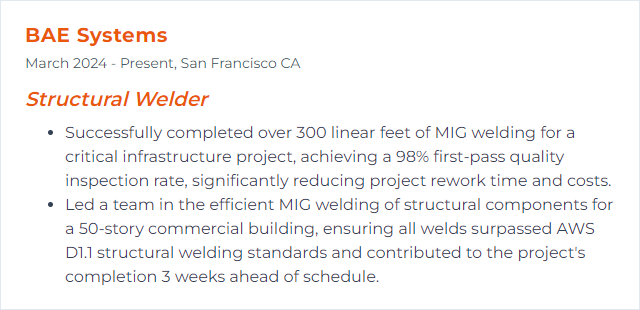
2. TIG Welding
TIG (GTAW) uses a non-consumable tungsten electrode with inert gas shielding to produce precise, clean welds. It shines on thinner sections, stainless, and nonferrous metals where distortion control and appearance matter.
Why It's Important
When the joint is critical and tolerance is tight, TIG offers surgical control, minimal spatter, and top-tier weld integrity.
How to Improve TIG Welding Skills
Absolute cleanliness: Degrease, brush with dedicated tools, and keep filler clean; contamination ruins puddles.
Tungsten prep: Proper grind direction, tip geometry, and size matched to amperage and material.
Body control: Brace hands, stay comfortable, and focus on repeatable torch and filler timing.
Heat management: Use foot pedal or fingertip control to shape the puddle and limit warping.
Position practice: Flat to overhead—build muscle memory for real-world fit-ups.
Filler selection: Match filler to base metal chemistry for strength and corrosion resistance.
Pulse when needed: Thin stock or heat-sensitive parts benefit from pulsed amperage for stability.
How to Display TIG Welding Skills on Your Resume
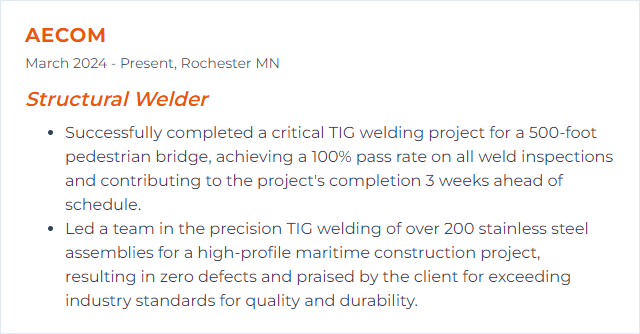
3. Stick Welding
Stick welding (SMAW) uses a flux-coated consumable electrode. Rugged, forgiving, and dependable outdoors, it’s a staple for structural work, heavy sections, and repair in the wind and weather.
Why It's Important
It goes where other processes struggle—remote sites, dirty steel, tight access—and still gets the job done.
How to Improve Stick Welding Skills
Set amperage right: Balance penetration and bead shape based on electrode type and diameter.
Choose electrodes wisely: 6010/6011 for root passes and gap-bridging; 7018 for strength and low hydrogen; match to position and spec.
Prep the joint: Remove rust, paint, oil; good starts begin with clean steel.
Arc length and angle: Keep the arc short and your travel angle consistent to avoid porosity and undercut.
Out-of-position reps: Vertical up, overhead, tight corners—practice until slag curls and beads stack neatly.
Safety discipline: PPE, ventilation, lead management, and fire watch—nonnegotiable.
How to Display Stick Welding Skills on Your Resume
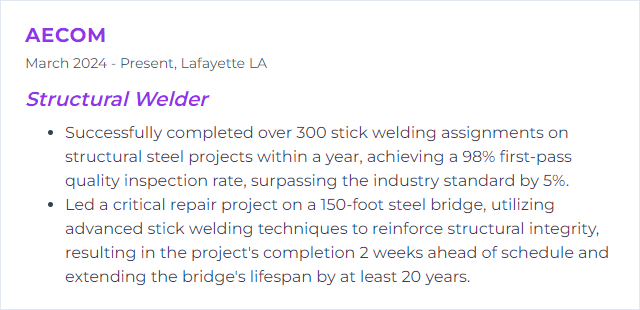
4. Flux-Cored Arc Welding
FCAW uses a tubular wire packed with flux, running self-shielded or gas-shielded. It chews through heavy plate, runs fast, and works well in the field across all positions.
Why It's Important
Speed and penetration without sacrificing toughness. For structural steel, that balance pays the bills.
How to Improve Flux-Cored Arc Welding Skills
Stick-out control: Typically 3/4 inch for self-shielded wires; maintain consistency to stabilize the arc.
Travel technique: Drag angle, slight weave when needed—tailor bead shape to joint and position.
Wire selection: Pick classifications that meet job specs (impact toughness, weathering steel, etc.).
Consumable care: Dry storage for wire; replace worn tips and check drive roll tension.
Surface prep: Clean, fit, and gap properly; FCAW is strong, not magic.
How to Display Flux-Cored Arc Welding Skills on Your Resume
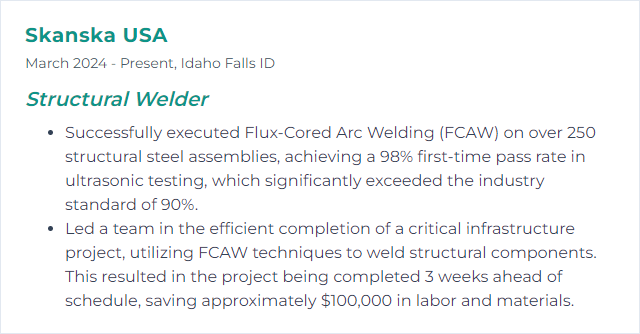
5. Blueprint Reading
Blueprint reading means turning lines and symbols into real steel. You’ll parse dimensions, materials, joints, and weld symbols (per standards such as AWS A2.4), then build to spec.
Why It's Important
Accuracy upstream prevents rework downstream. Misread drawings become misfit parts, and that domino falls hard.
How to Improve Blueprint Reading Skills
Master weld symbols: Groove types, fillet sizes, tail notes, contour, finish—read them without hesitation.
Work scales and views: Flip between plan, elevation, section, and detail; check scale changes.
Follow specs: Material grades, weld sizes, processes, inspection levels—tie every weld to a requirement.
Practice often: Study varied prints—bridges, buildings, plate work—to build speed and confidence.
Stay code-aware: Know which structural code governs the job and the acceptance criteria for your welds.
How to Display Blueprint Reading Skills on Your Resume
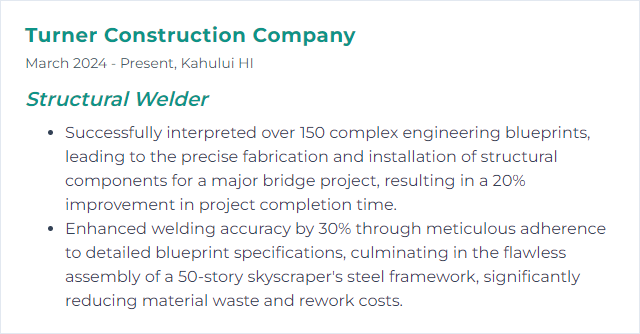
6. Precision Measuring
Precision measuring means verifying dimensions, angles, and alignment before, during, and after welding—using tools like squares, protractors, levels, calipers, and lasers to keep assemblies within tolerance.
Why It's Important
If it doesn’t fit, it doesn’t fly. Dimensional accuracy preserves structural integrity and keeps fabrication flowing.
How to Improve Precision Measuring Skills
Use the right tools: Digital calipers, calibrated tapes, feeler gauges, hi-lo gauges, laser levels—choose tools that match the tolerance.
Calibrate and care: Regular checks, protected storage, and temperature-aware measuring reduce drift.
Technique matters: Consistent datum points, correct contact pressure, and repeatable setups.
Account for distortion: Predict shrinkage, preset parts, and verify during tack-up—not after final weld.
Document: Record critical measurements and hold points for QA and traceability.
How to Display Precision Measuring Skills on Your Resume
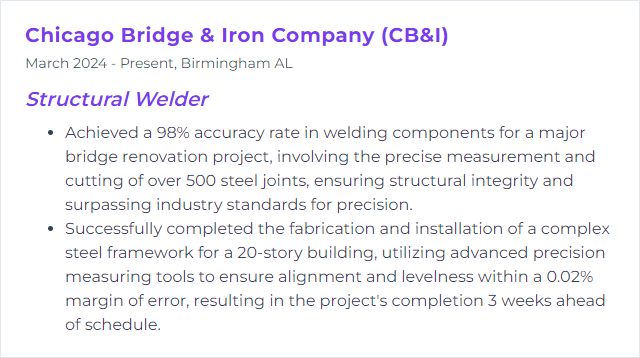
7. SMAW Technique
SMAW is the formal name for stick welding. Same process, different label. Technique drives results: arc length, whip-and-pause or straight stringers, and steady travel define bead shape and penetration.
Why It's Important
Versatile, portable, and dependable at height or on the ground—SMAW thrives where simplicity wins.
How to Improve SMAW Technique Skills
Angle and arc: 10–15° drag angle on most passes; keep the arc tight to reduce spatter and undercut.
Electrode strategy: Root with fast-freeze electrodes when gaps vary; cap with low-hydrogen for toughness.
Heat input control: Tune amperage and travel to avoid lack of fusion or excessive crown.
Position practice: Vertical up techniques for penetration; overhead beads with controlled weave.
Inspect and adjust: Chip, brush, and examine every pass; fix defects before they hide.
How to Display SMAW Technique Skills on Your Resume
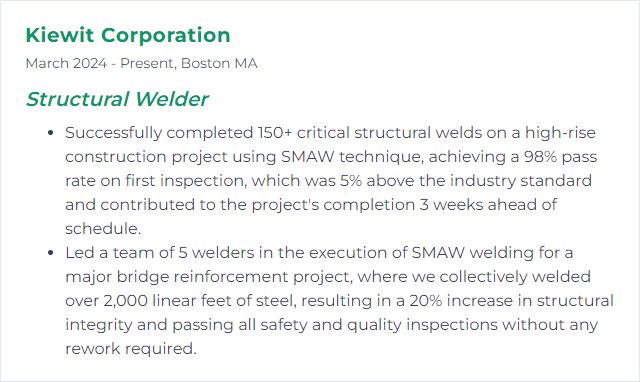
8. GTAW Technique
GTAW is TIG by another name. A stable arc, clean shielding, and gentle heat control produce premium welds on stainless, aluminum, and thin sections.
Why It's Important
High-integrity joints with low distortion. When aesthetics and performance both matter, this is the move.
How to Improve GTAW Technique Skills
Consistent torch angle: About 15–20°; keep the arc short for tighter control.
Filler timing: Dip with rhythm; aim for even ripples and uniform reinforcement.
Shielding discipline: Set post-flow, protect hot metal, and mind drafts to prevent porosity.
Tungsten selection: Size and composition matched to current type and base metal.
Heat shaping: Pulse or taper amperage to manage edges, corners, and starts/stops.
How to Display GTAW Technique Skills on Your Resume
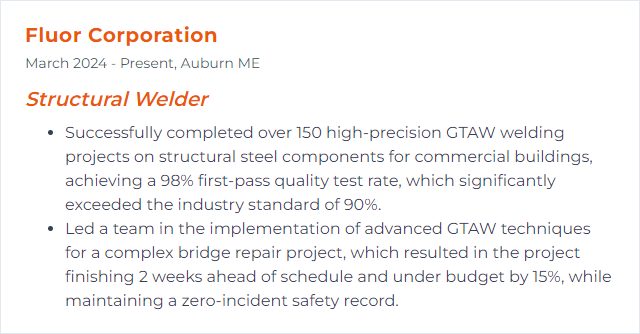
9. GMAW Technique
GMAW is MIG—same process, different acronym. The technique piece is about machine tuning, torch control, and bead consistency across positions.
Why It's Important
Fast deposition with quality you can repeat. Structural work rewards both.
How to Improve GMAW Technique Skills
Set parameters: Voltage, wire feed, and inductance tuned to joint design and thickness.
Torch angle: Push for flatter beads and better visibility; drag for deeper penetration—choose based on the joint.
Travel speed: Too fast gives underfill; too slow causes excess buildup and heat input.
Bead discipline: Straight stringers for most structural work; controlled weave only when specified.
Seek feedback: Review cross-sections, watch for fusion at toes, and adjust continuously.
How to Display GMAW Technique Skills on Your Resume
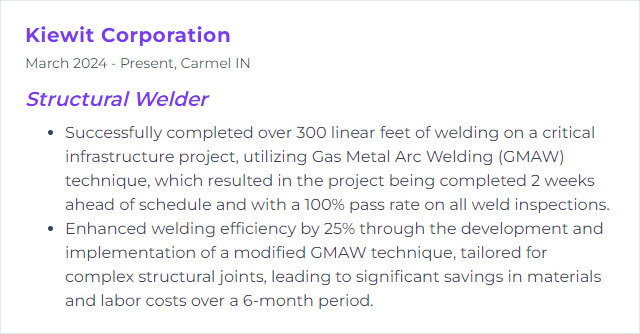
10. FCAW Technique
FCAW technique differs by wire type: self-shielded for field work and wind, gas-shielded for cleaner beads and lower spatter. Both demand tight control over stick-out, travel, and manipulation.
Why It's Important
It merges productivity with toughness, making it a go-to for thick structural members.
How to Improve FCAW Technique Skills
Confirm polarity and gas (if used): Wrong polarity or gas flow wrecks arc stability.
Consistent stick-out: Hold steady to keep current and penetration uniform.
Read the puddle: Listen for a steady crackle, watch slag lines, and tune parameters to what you see and hear.
Position-specific moves: Slight weave vertical up; tighter stringers overhead for control.
Safety first: Fume control, proper PPE, and burn management—especially with self-shielded wires.
How to Display FCAW Technique Skills on Your Resume
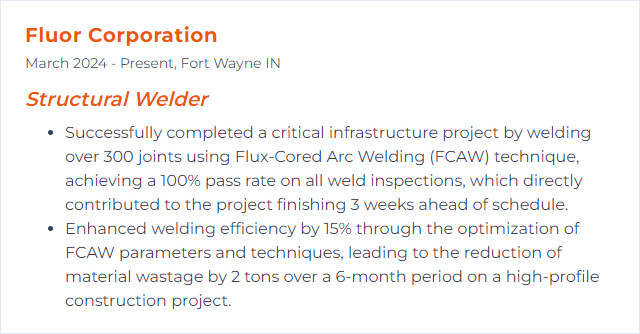
11. Oxy-Fuel Cutting
Oxy-fuel cutting heats steel to ignition temperature and blasts pure oxygen to oxidize and remove metal. It’s reliable for plate cutting, bevels, and rough shaping on site.
Why It's Important
Accurate cuts speed fit-up, reduce grinding, and keep assemblies on line and on time.
How to Improve Oxy-Fuel Cutting Skills
Select the right tip: Match tip size to plate thickness for clean kerfs.
Set pressures properly: Stable preheat flames and correct oxygen pressure make or break cut quality.
Maintain speed and standoff: Too fast leaves slag; too slow widens the kerf and overheats edges.
Keep gear clean: Torch, tip, and hoses in good condition; leaks or blockages are hazards and quality killers.
Follow safety protocols: Flashback arrestors, check valves, correct cylinder handling, and a tidy spark area.
How to Display Oxy-Fuel Cutting Skills on Your Resume
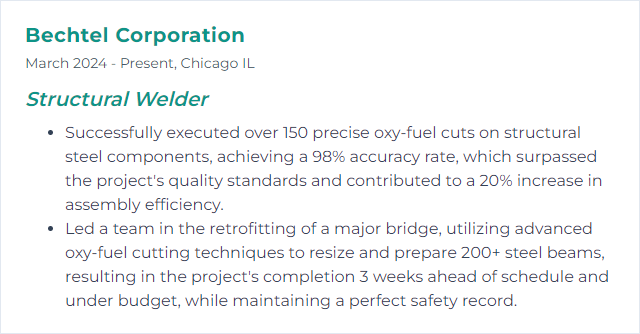
12. Plasma Cutting
Plasma cutting ionizes gas into a focused jet that slices conductive metals with speed and precision. Great for clean edges, intricate shapes, and mixed thicknesses.
Why It's Important
Fast setup, minimal dross, and crisp lines reduce downstream cleanup and improve fit-up.
How to Improve Plasma Cutting Skills
Match consumables to the job: Nozzles, electrodes, and shields sized for current and thickness.
Set air and amperage correctly: Stable airflow and the right current keep the arc tight and cuts square.
Hold a consistent speed: Listen for a smooth hiss, watch the arc trail, and keep slag peeling off the bottom.
Use guides: Straightedges and templates tighten accuracy for long cuts and repeat parts.
Maintain the torch: Replace worn parts early; a tired nozzle makes ugly cuts.
How to Display Plasma Cutting Skills on Your Resume

